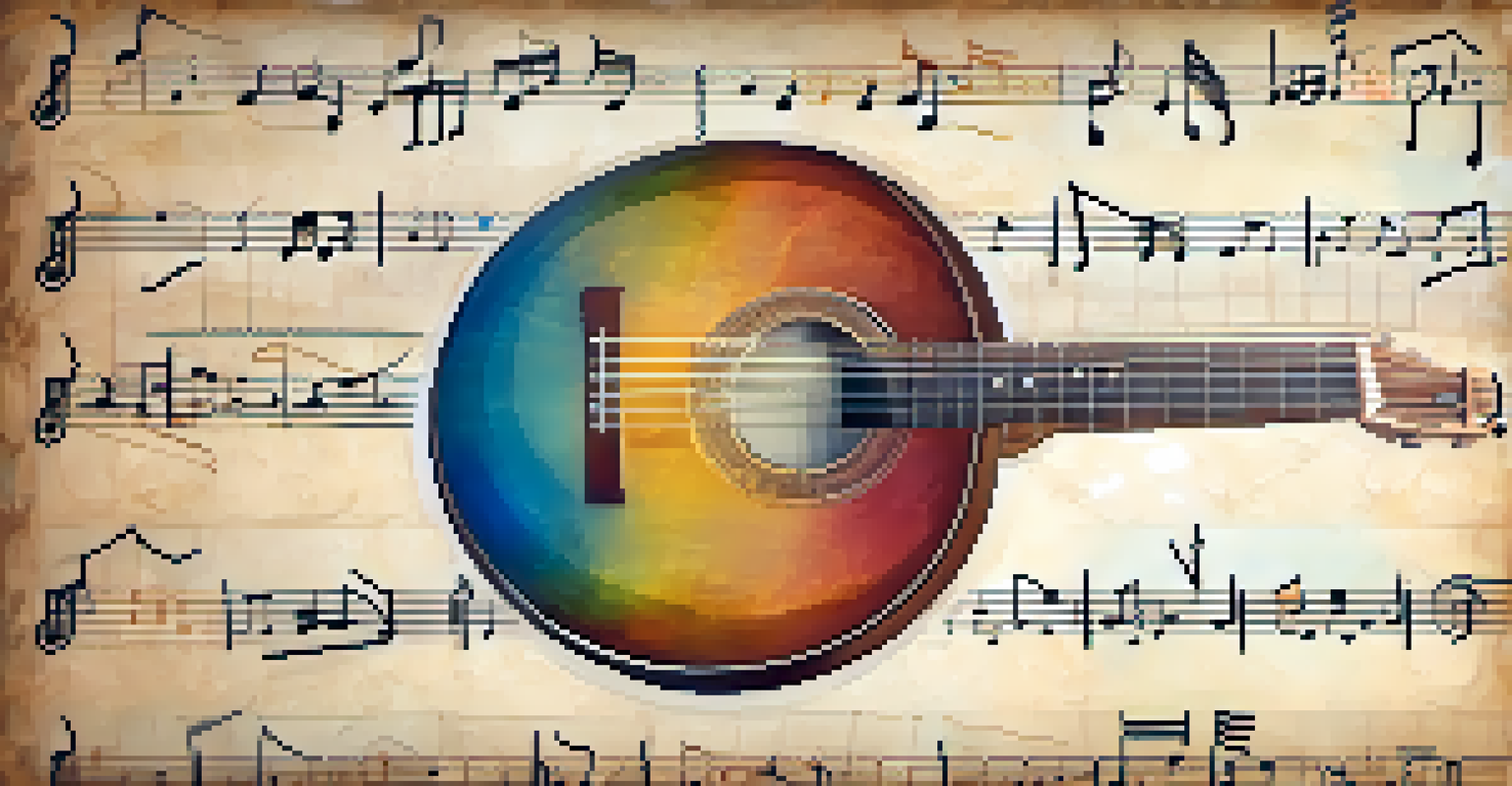The Importance of Key Signatures for Guitar Composition

What Are Key Signatures and Why Do They Matter?
Key signatures are a set of sharp or flat symbols placed on the staff, indicating the key of the piece. They tell you which notes will be sharp or flat throughout the composition, shaping the overall sound and mood. Understanding key signatures is essential for guitarists to navigate their compositions effectively.
Music is the shorthand of emotion.
Without a solid grasp of key signatures, guitarists might find themselves lost, unsure of which notes to play. This can lead to confusion, especially when collaborating with other musicians. By mastering key signatures, you can ensure that your music aligns with others, creating a harmonious experience.
In essence, key signatures serve as a roadmap for your musical journey, guiding you through the intricacies of your composition. They not only help define the sound but also enhance your creativity, allowing you to explore different musical landscapes.
The Role of Major and Minor Keys in Composition
Major and minor keys evoke different emotions and atmospheres in music. Major keys often sound bright and happy, while minor keys tend to convey sadness or tension. As a guitarist, choosing between these keys can dramatically influence the feel of your piece.

For instance, if you're writing a joyful song, a major key will help you project that emotion more clearly. Conversely, if you're aiming for a haunting ballad, a minor key might be the better option. Understanding how these keys work allows you to tailor your compositions to evoke the desired mood.
Key Signatures Guide Composition
Key signatures serve as a roadmap for guitarists, indicating which notes will be sharp or flat and shaping the overall sound and mood of the music.
Being aware of the emotional implications of key choices can inspire you to experiment with your guitar writing. It can lead to unexpected twists in your music and help you communicate more effectively with your listeners.
How Key Signatures Affect Guitar Chord Progressions
Key signatures play a pivotal role in determining which chords work well together in a piece. Each key has its own set of diatonic chords, which are the chords built from the notes in that key. For guitarists, this means that understanding key signatures can simplify the songwriting process.
The beauty of music is that it connects people. It carries the emotion of the moment.
For example, if you're in the key of C major, the chords of C, Dm, Em, F, G, Am, and Bdim are your go-to options. This knowledge can help you create smooth transitions and cohesive progressions that flow naturally. It also opens up opportunities to add variations and embellishments.
By mastering the relationship between key signatures and chord progressions, you can become more confident in your songwriting. This knowledge allows you to break free from common patterns and explore new, creative avenues in your guitar compositions.
Transposing: A Key Skill for Guitarists
Transposing is the process of changing the key of a piece while maintaining its structure. This skill is invaluable for guitarists, especially when collaborating with other musicians who may prefer different keys. Understanding key signatures makes transposing easier and more intuitive.
For instance, if you have a song in the key of G major but wish to play it in A major, knowing how to shift all your chords up a whole step is crucial. This allows you to adapt your music without losing its essence or emotional impact. It’s like being able to speak multiple languages in the world of music.
Major vs Minor Keys Impact Emotion
The choice between major and minor keys can evoke different emotions, with major keys sounding bright and happy, while minor keys convey sadness or tension.
Practicing transposition can enhance your overall musicianship and flexibility as a guitarist. With this skill, you can adjust your compositions to suit various vocal ranges or instrumental arrangements, making your music more versatile.
Enhancing Melodic Creativity Through Key Signatures
Key signatures not only influence harmony but also shape melodic creativity. By understanding the notes available in a given key, you can craft melodies that resonate with your intended emotion. This knowledge helps in avoiding dissonance and ensuring that your melodies are engaging and memorable.
For example, if you're composing in E minor, you can explore the natural minor scale and its variations to build unique melodic lines. This exploration can lead to unexpected and delightful musical ideas that enhance your composition. Think of it as a painter choosing colors from a palette to express a specific feeling.
By embracing the framework that key signatures provide, you can push the boundaries of your melodic creativity. This can lead to more compelling guitar solos and memorable hooks in your compositions.
The Impact of Key Changes on Musical Dynamics
Key changes, or modulations, can dramatically shift the energy and dynamics of a piece. By transitioning from one key to another, you can create tension, surprise, and excitement within your music. This technique is often used in guitar compositions to engage and captivate the listener.
Consider how a sudden change from C major to E minor can evoke a different emotional response. This kind of shift can heighten the drama of your composition, making it more dynamic and interesting. It’s akin to adding a plot twist in a story that keeps the audience on their toes.
Transposing Simplifies Collaboration
Transposing allows guitarists to change the key of a piece while maintaining its structure, making it easier to adapt music for different musicians and settings.
Learning how to effectively implement key changes can elevate your compositions, taking them beyond simple melodies and chords. It allows you to explore a wider emotional range, keeping your listeners intrigued and invested in your music.
Practical Tips for Mastering Key Signatures on Guitar
To effectively master key signatures, start by familiarizing yourself with the circle of fifths. This visual tool helps you understand the relationships between different keys and their corresponding signatures. It’s like having a cheat sheet for navigating your musical landscape.
Practice playing scales and chords in various keys to build your confidence and fluency. This will not only improve your technical skills but also deepen your understanding of how key signatures shape your music. Regular practice is key to becoming comfortable with these concepts.

Lastly, experiment with writing short pieces in different keys. This hands-on approach will reinforce your learning and inspire creativity. Remember, the more you explore, the more you’ll discover about the power of key signatures in your guitar compositions.
Conclusion: Embrace the Power of Key Signatures
Understanding key signatures is essential for any guitarist looking to enhance their composition skills. They provide the foundation for creating melodies, harmonies, and emotional depth in your music. Embracing this knowledge can transform your songwriting and broaden your creative horizons.
As you continue your musical journey, keep experimenting with different keys and their signatures. This will not only improve your technical abilities but also deepen your connection to the music you create. Remember, every key has its unique story waiting to be told.
In the end, the more you engage with key signatures, the more effective and expressive your guitar compositions will become. So, pick up your guitar, dive into those keys, and let your creativity flow!